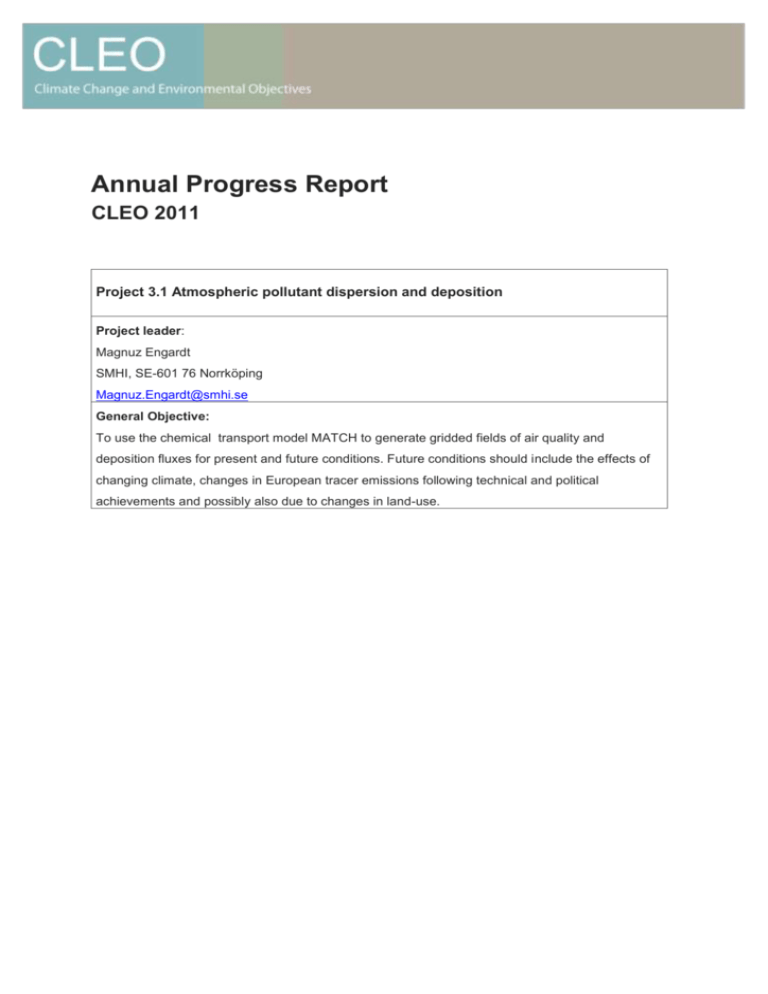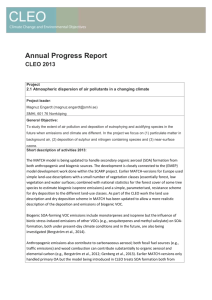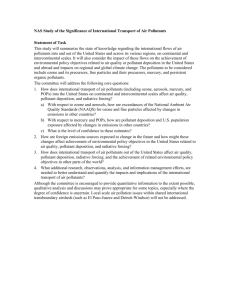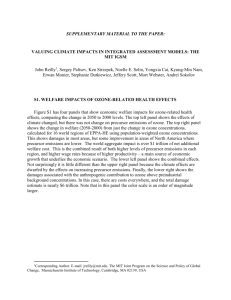Pollutant dispersion and deposition - CLEO
advertisement

Annual Progress Report CLEO 2011 Project 3.1 Atmospheric pollutant dispersion and deposition Project leader: Magnuz Engardt SMHI, SE-601 76 Norrköping Magnuz.Engardt@smhi.se General Objective: To use the chemical transport model MATCH to generate gridded fields of air quality and deposition fluxes for present and future conditions. Future conditions should include the effects of changing climate, changes in European tracer emissions following technical and political achievements and possibly also due to changes in land-use. Short description of activities 2011: During 2011 we have completed a large number (~10) of long (100-140 years) simulations aimed at exploring the effect of different tracer emissions scenarios and hemispheric boundary concentrations. Data is available to partners in CLEO. We have particularly focussed on the impact of changing hemispheric concentrations of O3 –which will strongly affect surface O3 in Sweden. The results are discussed in a manuscript which has been submitted to a scientific journal and is currently under review. Appendix 1 shows possible evolution of surface ozone in the Nordic countries. We have also worked with nitrogen and sulphur deposition during present and future times. For future deposition, the driving climate data matters more than for e.g. surface ozone. We are therefore expanding the suite of available simulations (different climate downscalings) and expect additional results available in early 2012. The actual levels will, however, foremost be determined by future nitrogen and sulphur emissions in Europe, which are expected to decrease. The results are currently processed and a scientific paper is being prepared. For current nitrogen and sulphur deposition we have evaluated the model against different datasets available in Sweden. The results are encouraging although a comparison with data from MAGIC suggests that subgrid downscaling or bias correction may have to be applied. Methods for this are being investigated. Appendix 2 shows examples of deposition at a “CLEO-sites” and Appendix 3 gives an example of MATCH performance for current climate. We have been exploring possible alternative future tracer emission scenarios together with CLEOproject 1.3. We will probably wait for the release of dedicated European emission scenarios being developed in other climate-change air-quality projects where SMHI is participating (see below). Such data will be available during the summer of 2012, the latest. Deliverables 2011: D3.1.1 Gridded data on concentrations and depositions (month 12). Done. Gridded data available for the full period 1990-2100 for two different climate scenarios (downscaled HadCM3 and ECHAM5) and for two emissions scenarios (time varying emissions according to RCP4.5 and constant emissions (at 2000 values). D3.1.2 Improved routine for downscaling of O3 fluxes to vegetation (month 24). Delayed but work is underway, will be completed during 2012. Additional staff involved in project: Joakim Langner and Camilla Andersson, SMHI Per-Erik Karlsson (IVL); Håkan Pleijel and Jenny Klingberg (GUM) Co-operation outside CLEO: The current project benefits from the strong links with other research projects dealing with the connection between climate change and European air quality. Particularly ENSCLIM funded by the Nordic Council of Ministers (project no: KoL-10-04) and the EU FP7 projects ECLAIRE (project no: 282910) and IMPACT2C (project no: 282746), which both commenced in late 2011. Reports and publications: Andersson, C. and Engardt, M. 2010. European ozone in a future climate: Importance of changes in dry deposition and isoprene emissions. J. Geophys. Res., 115, D02303. doi:10.1029/2008JD011690 Langner, J., Engardt, M. and Andersson, C. 2012. Modelling the impact of climate change on air pollution over Europe using the MATCH CTM linked to an ensemble of regional climate scenarios. In: Air Pollution Modeling and its application XXI (Eds. D.G. Steyn and S.T. Castelli). Springer Science+Business Media B.V., pp. 627-635. DOI: 10.1007/978-94-007-1359-8_103 J. Langner et al. 2012. A multi-model study of impacts of climate change on surface ozone in Europe. Accepted for publication in Atmospheric Chemistry and Physics Discussions. Langner, J., Engardt, M. and Andersson, C. 2011. European surface ozone 1990-2100. Submitted manuscript. Engardt, M and Langner, J. Simulations of nitrogen species over Europe using meteorological data from different regional climate downscalings. Manuscript in preparation. Oral presentations: “Web Services for Incorporation of Air Quality and Climate Change in Long-Term Urban Planning for Europe” Presentation by M. Engardt at ISESS 2011 - the International Symposium on Environmental Software Systems, Brno 27-29 June 2011. “High-resolution photochemical modelling of air quality in Stockholm. Current and future situation” Presentation given by M. Engardt at UAQCC – Urban air quality and climate change. Joint workshop of WMO and KlimaCampus, Univ. Hamburg. 16-18 August 2011. “Ozone evolution under climate change” Presentation by M. Engardt at SMHI 9 Dec 2011. Appendix 1. The figure shows modelled summertime (April-September) average surface ozone concentration averaged over Sweden, Norway, Finland end extreme north-western Russia (Kola peninsula and Karelia). HAD_RCP2000_BC2000 (cyan) and ECH_RCP2000_BC2000 (blue) show the impact of climate change alone from 1990-2100, tracer emissions and boundary concentrations are kept constant. ECH_RCP4.5_BC2000 (black line) shows the combined effect of changing climate and changing tracer emissions in Europe. In ECH_RCP4.5_BCtrend (our “best estimate of the future”; red line) we have combined the effect of changing climate, changing tracer emissions and a possible evolution of hemispheric background concentrations of ozone and methane. As can be deduced from the figure will climate change alone result in small changes of surface concentration over Sweden and its neighbouring countries. Simulations performed with different climate downscalings (HadCM3 vs. ECHAM5) differ marginally. Changing tracer emissions in Europe would lead to clearly decreasing surface ozone in the region, where it not for the increasing hemispheric background which will to a large degree control surface ozone in this area. Appendix 2. The figures compare modelled and measured deposition of oxidised nitrogen at CLEO-site Kindla (59.75ºN 14.91ºE). Blue dots are monthly values from the model, purple circles are monitoring data. Black horizontal bars indicate mean values - in the model - over different target periods. MATCH ave and Obs. Ave is the average and standard deviations of the monthly values from the model and observations during the period with observations. Note that individual months are not expected to coincide since model run is forced by meteorology from a climate model which should only reproduce the average and variability of the real world. The two panels depict simulations with time varying European tracer emissions according to RCP4.5. forced with downscaled meteorology from HadCM3 and ECHAM5, respectively. The impact of reduced nitrogen emissions in the future is clearly seen. Appendix 3 The figures show a comparison between sulphur and nitrogen dry and wet deposition for present climate. Monitoring data is taken from “Krondroppsnätet”. Modelled data is from a MATCH simulation using downscaled HadCM3 climate with temporally varying tracer emissions according to RCP4.5. Data is averaged over the periods with observations (4-7 years around 2005). While the wet deposition in MATCH deviates less than a factor of two from observations is the correspondence with observed dry deposition poorer. The reason for the discrepancies can be sought both in measurement problems, unrepresentative meteorology during the 5 year period, erroneous emissions or imperfections in the model.









